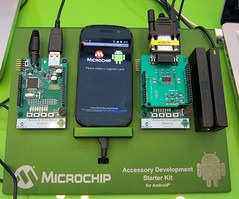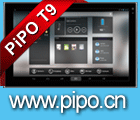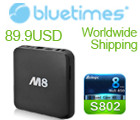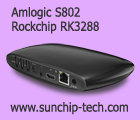Following is my summary and my top-20 videos filmed during 10 days spent in Shenzhen and Hong Kong, at 3 tradeshows, filming, interviewing, uploading and posting 97 videos from the Shenzhen Electronics Fair (April 8-10th), China Sourcing Fair (April 12-15th) and HKTDC Electronics Fair (April 13-16th). With all those many videos posted, it can be hard for you to look through all of them to find out which are the best. That is why I now always summarise my best videos in a post in the Top Video Lists category. Many awesome new ARM Cortex-A9 tablets and cheap smartphones were shown.
New major ARM processor trends from the Shenzhen and Hong Kong tradeshows and markets:
Based on the overwhelming amount of new videos filmed related to those new processors, I added 3 new Chip provider categories to ARMdevices.net:
– AmLogic, I filmed 9 new videos: [1], [2], [3], [4], [5], [6], [7], [8], [9] (in order of most to least interesting), it’s a new low-cost Single-Core Cortex-A9 processor, clocked at 800Mhz for now, it can be found in the first sub-$100 Cortex-A9 tablets (resistive). The performance of these are likely better than 1Ghz Cortex-A8, but I will test this on my Kinstone AmLogic tablet sample (that I bought for $130 (850 renminbi)) and report in my upcoming second part video-review soon.
– Mediatek, I filmed 10 new videos: [1], [2], [3], [4], [5], [6], [7], [8], [9], [10] (in order of most to least interesting), this low-cost ARM9 processor seems to win big in the Chinese made emerging Android smartphones market. It’s absolutely amazing how cheap some of the Mediatek MTK6516 based Smartphones are being sold at, I bought a $87 FG8 Mediatek MTK6516 based Android Smartphone (that looks similar to a HTC Desire with its casing design). With Mediatek’s upgraded ARM11 3G-enabled MTK6573 Smartphone processor coming up, they may again make big wins in the Chinese smartphone market and bring sub-$100 maybe soon sub-$50 Android smartphones to the worldwide (not only emerging) mass market. Amazing.
– NEC/Renesas, I filmed 7 new videos: [1], [2], [3], [4], [5], [6], [7] (in order of most to least interesting), about 2 years ago, NEC Electronics and Renesas merged and out of that merger is coming this new NEC/Renesas EV2 ARM Cortex-A9 Dual-Core 533Mhz processor, the SoCs based on it are very low priced. Consider this to be the Japanese ARM Cortex-A9 Dual-Core entrant. Some of my reports claim that a nice capacitive tablet design based on this processor can be sold in bulk for as little as $110, $125 or $135. I bought a sample from Livall.cn for $171 which I will soon video-review further.
My top-20 best Shenzhen/HongKong April 2011 videos:
1. Archos 7c Home Tablet, RK2918 Capacitive, Archos are building amazing value tablets based on the Rockchip RK2918 ARM Cortex-A8 1.2Ghz processor, with great capacitive touch screens, and they are bringing that to the definitely sub-$200 price range. As I am probably the biggest Archos fanboy in the world (I’m the admin and founder of http://forum.archosfans.com), I found it super fascinating to meet their expert staff and visit their Shenzhen headquarters.
2. Arnova 10 capacitive RK2918 to be released in May, at possibly $229 MSRP, for this 10.1″ capacitive Rockchip RK2918 ARM Cortex-A8 1.2Ghz tablet, it’s hard to find better value 10″ tablet. Consider this kind of price is for a product that will be massively available at all retail stores in Europe and the USA, that price is the retail price, including all import taxes, fees, margins and everything. I believe Archos can make huge sales of their new Arnova line, especially now that they are able to bring ARM Cortex-A8 performance and nice capacitive screens to these entry-level priced devices.
3. Best of Shenzhen: $87 Android 3.5″ capacitive phone, MTK6516 FG8, that is my initial video review of my new FG8 $87 Android Smartphone. Mediatek MTK6516 based, with Android 2.2 Froyo and a 3.5″ HVGA Capacitive touch screen. This is amazing to see how cheap the Android smartphones are getting. Check back for my further video reviews coming up to show the performance and features of this cheap smartphone platform.
4. Shenzhen Behind the Scenes 1: Hongda Factory tour, a fascinating look inside of a small Shenzhen consumer electronics factory. That day they are manufacturing Intel Atom based netbooks, the day before they were making cheap Freescale i.MX51 based tablets for utopiacn.
5. Geniatech explains their AmLogic Cortex-A9 Single Core Set-top-box, an interview with the product manager on this sub-$100 AmLogic based set-top-box, watch this to get an idea how the potential upcoming Google TV on ARM based set-top-box makers are planning their global sub-$100 ARM Powered Set-top-box market entry.
6. $95 Cortex-A9 Tablet Review, Kinstone KS-UMD070A9, my initial review of this sub-$100 (bulk, resistive) ARM Cortex-A9 AmLogic 800Mhz Single Core tablet. I’ve got the review sample right here, so I will post a further full video review with benchmarks, video codec tests and other speed tests as soon as I get the time, check back for that.
7. Shenzhen Behind the Scenes 3: Richtechie.com, Freescale i.MX51/53 PCB designer, have a look behind the scenes at a PCB designer in Shenzhen. This PCB design house makes Freescale i.MX51 motherboards and they are working on their upcoming i.MX53 based PCB designs. They work with utopiacn.
8. Archos at the Shenzhen Electronics Fair, not much news in this video, it’s just interesting to see how Archos has a big booth at the Shenzhen Electronics Fair and uses it to do sales of their devices towards growing their sales in the Chinese mainland market.
9. Catwalk girls show Tablets and Smartphones in Shenzhen, just fun if you would like to see how the Tablets and Smartphones are the center of the trendy topic at the Shenzhen Electronics Fair.
10. NEC/Renesas EV2 ARM Cortex-A9 Dual-Core 533Mhz in videos with Livall.cn, Gaia, Ebot, Quality Industrial and TAL Electronics.
11. Rockchip Rk2918 in a Set-top-box, this could power a sub-$50 ARM Powered Google TV Set-top-box.
12. Honeycomb at the Rockchip booth (just keyrings for now..), once you get Honeycomb on the Rockchip RK2918 (could be happening by Google I/O on May 10-11th?), that could create the most explosive disruptive mix for the tablet industry. Also check-out my video of the Rockchip RK2918 based laptop which could also provide great value for an ARM Powered laptop running Chrome OS or Honeycomb.
13. Review: $120 Hero H2000 MTK6516 Android Froyo Powered iphone4-copy, my initial video review of my new $120 iphone4-clone that seems to run Android 2.2 super smoothly on this 3.5″ HVGA capacitive touch screen Mediatek MTK6516 based Hero H2000 smartphone. It’s probably manufactured by Karasnn.com.
14. Epudo Telechips Cortex-A8 tablets, the new Telechips 8803 ARM Cortex-A8 1.2Ghz processor may be reaching stability for Android Gingerbread support. Telechips 8803 ARM Cortex-A8 1.2Ghz Gingerbread also featured in videos with Digilink and huashiguang.
15. MID123.com Hummingbird Gingerbread Tablet, Gingerbread seems also to be reaching stability on the Samsung ARM Cortex-A8 Hummingbird processor platform.
16. Karasnn.com Hero Android MTK6516 Smartphones, interview with one of the potentially leading Mediatek MTK6516 based Android smartphone makers.
17. Meizu M9, $380 Android phone with Retina Display, interesting to see a 3.5″ Retina Display and the Samsung Hummingbird ARM Cortex-A8 1Ghz processor in this new Meizu M9 phone. At $380 unlocked it’s expensive, but surely less expensive than an iPhone while having pretty similar hardware performance. Meizu has several stores in the Shenzhen electronics market area, they seem to be a relatively big smartphone brand in China.
18. Trend Technology (HK) Ltd does Android Tablets, discussion with an insider how to get those tablets made and distributed.
19. Performance test on AmLogic ARM Cortex-A9 Android Set-top-box, testing the performance doing web browsing and more on this AmLogic development board. It seems fast!
20. Ramos booth tour, featuring Ramos W18, 9.7″ capacitive ARM Cortex-A9 AmLogic Android Tablet, Ramos has nice new products. Also check my videos of the Ramos T8Pro and Ramos V70/T11Pro/T11AD.
While in Shenzhen, I filmed following 5-part series of videos showing a bit of the Behind the Scenes of Shenzhen, the capital of the world for consumer electronics manufacturing:
1: Hongda Factory tour
2: utopiacn, Apad Android Tablet maker
3: Richtechie.com, Freescale i.MX51/53 PCB designer
4: Walking around the Shenzhen smartphone market
5: 3Gnet Factory Tour
Flying back from Hong Kong to Copenhagen using the excellent and cheap airline Qatar Aiways, they can provide free stop-over in Doha (that can be booked using their Multi-city online booking feature), also check these 3 videos that I filmed, they are not very tech related, but they show the atmosphere in an interesting Middle-eastern Golf country:
1. Arrived in Qatar
2. Walking the Souq Waqif, the Corniche and checking out the Doha skyscrapers at night
3. Desert Safari with Arabian Adventure Qatar (includes a fun Video-review of the NEC/Renesas based dual-core ARM Cortex-A9 533Mhz capacitive 7″ tablet from livall.cn)






